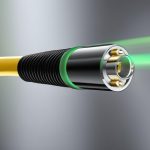Outdoor networking solutions require reliable connectivity and robust performance in all weather conditions. As the future of IoT and smart city development relies heavily on outdoor edge compute, it becomes crucial to find cost-effective infrastructure connections and secure suitable locations for equipment. Cable operators have built extensive networks of fiber optic and coaxial cables, making them an ideal choice for outdoor deployments in urban and industrial areas.
Implementing coaxial cables in outdoor networking solutions ensures reliable and efficient outdoor connectivity. These solutions have diverse applications in public safety, traffic management, parking, city management, and environmental monitoring. To enable these applications, the deployment of interconnected sensors and processors is essential. Coaxial cables offer a plug-and-play model with secure, reliable connectivity, making them ideal for rapid-scale deployment of computing devices and micro-networks.
Power and backhaul are critical considerations for outdoor deployments. Acquiring a utility connection can be time-consuming and costly, while power impairments can negatively impact the system availability. Coaxial cables provide clean power and uninterrupted power supplies, ensuring network reliability even during power outages. Connecting devices is as simple as plugging into the coax cable using an outdoor cable modem, delivering low-latency gigabit speeds.
Maintaining and managing outdoor networks is a top priority for cable operators, who invest significantly in building and maintaining network infrastructure. With trained installation and service teams, they offer best practices and advanced, managed services like redundancy and security protocols. Additionally, seamless integration with fiber services and existing OSS and BSS functions ensures efficient network operation.
In conclusion, implementing coaxial cables in outdoor networking solutions provides reliable connectivity and robust performance. Cable operators’ extensive networks of fiber optic and coaxial cables make outdoor coaxial solutions cost-effective and dependable for outdoor deployments in urban and industrial areas. This infrastructure ensures the success of outdoor network deployments and enables the benefits of edge devices in outdoor environments.
Last Mile Infrastructure: Leveraging Coaxial Cable for Outdoor Connectivity
Cable operators have constructed vast networks of distributed fiber optic and coaxial cables that cover most populated areas worldwide. While fiber optics are commonly used for long-distance trunk communication, older established areas utilize existing coaxial cable infrastructure for last-mile connectivity in outdoor networking solutions.
Coaxial cables provide a plug-and-play model with secure, reliable connectivity and aerial installation, making them ideal for the rapid-scale deployment of computing devices and micro-networks. Cable operators address siting challenges through franchise agreements, eliminating the need for permits or additional costs when installing equipment.
Additionally, coaxial cables are energized with clean power and provide hours of energy storage through batteries, ensuring uninterrupted power supply during utility outages.
Benefits of Coaxial Cable for Outdoor Connectivity:
- Secure and reliable connectivity
- Plug-and-play installation
- Aerial deployment
- Cost-effective franchise agreements
- Uninterrupted power supply
Power and Backhaul: Critical Considerations for Outdoor Deployments
When it comes to outdoor deployments, power and backhaul are crucial considerations for ensuring reliable connectivity. Cable broadband’s coaxial cables provide an excellent solution to address these challenges.
Acquiring a utility connection for outdoor deployments can be time-consuming and costly. It often involves obtaining permits, engaging in construction activities, and connecting to meter systems. These processes can cause delays and increase expenses. However, by leveraging cable broadband’s coaxial cables, outdoor deployments can avoid these hurdles and achieve reliable power connections.
Power impairments from utilities can have a significant impact on the performance of sensitive electronic equipment, leading to system availability issues. To mitigate this risk, cable broadband’s coaxial cables are energized with clean power. Additionally, these cables are equipped with uninterruptible power supplies (UPS), which provide hours of energy storage. This ensures uninterrupted power supply even during power outages, establishing network reliability for outdoor deployments.
Connecting devices to the network in outdoor deployments is a seamless process with coaxial cables. All it takes is plugging the devices into the coax cable using an outdoor cable modem. The latest DOCSIS 3.1 modems deliver low-latency gigabit speeds with symmetrical multi-gigabit fiber-like performance. This ensures high-speed connectivity for outdoor networks, enabling smooth data transmission and rapid access to critical applications.
“By leveraging cable broadband’s coaxial cables, outdoor deployments can avoid time-consuming and costly utility connections, and achieve reliable power supply.”
To illustrate the benefits of coaxial cables in outdoor deployments, consider the following table comparing power and backhaul considerations:
| Consideration | Utility Connection | Cable Broadband’s Coaxial Cables |
|---|---|---|
| Power Supply | Time-consuming and costly process | Energized with clean power and equipped with uninterruptible power supplies (UPS) |
| Reliability | Potential power impairments from utilities | Ensured network reliability even during power outages |
| Connection Process | Involves multiple steps and coordination with utilities | Simple plug-and-play connectivity using outdoor cable modems |
As the table demonstrates, cable broadband’s coaxial cables offer a streamlined and dependable power and backhaul solution for outdoor deployments.

Maintaining and Managing Outdoor Networks
Cable operators invest billions annually in building and maintaining network infrastructure, making network maintenance and management a top priority. They have trained installation and service teams, leveraging best practices and equipment to ensure network reliability.
Here are some key strategies employed by cable operators in maintaining and managing outdoor networks:
- Support for Additional Plugin Items: Cable operators provide support for additional plugin items like Wi-Fi access points or future edge compute systems. These items can be easily integrated into the existing network infrastructure with minimal additional training or resources, allowing for scalability and expansion of outdoor networks.
- Best Practices and Standards: Cable operators promote best practices through standards that define how networks operate. This ensures consistency and uniformity in network management, minimizing downtime and optimizing performance. Furthermore, adherence to industry standards such as layer 2 security protocols, redundancy, and bundled services enhances network security and reliability.
- Seamless Integration: Cable operators ensure seamless integration with operator fiber services and existing OSS (Operations Support Systems) and BSS (Business Support Systems) functions. This eliminates compatibility issues and facilitates efficient network management and maintenance.
Cable operators’ emphasis on maintaining and managing outdoor networks extends beyond infrastructure alone. They provide advanced, managed services such as:
- Layer 2 security protocols to protect against unauthorized access and data breaches.
- Redundancy measures to ensure uninterrupted connectivity and reliability.
- Bundled services that offer comprehensive solutions for network management, security, and performance optimization.
In summary, cable operators prioritize network maintenance and management to ensure the reliable and efficient operation of outdoor networks. By investing in trained teams, implementing best practices, and offering advanced services, they ensure that outdoor networks remain robust, secure, and optimized for performance.
Key Strategies for Maintaining and Managing Outdoor Networks
| Strategies | Benefits |
|---|---|
| Support for Additional Plugin Items | Scalability and flexibility in expanding outdoor networks |
| Best Practices and Standards | Consistent network operation, minimizing downtime |
| Seamless Integration | Efficient network management and maintenance |
| Layer 2 Security Protocols | Enhanced network security and protection against unauthorized access |
| Redundancy Measures | Uninterrupted connectivity and reliability |
| Bundled Services | Comprehensive solutions for network management, security, and performance |
Conclusion
Implementing coaxial cables in outdoor networking solutions provides reliable and robust connectivity for a wide range of applications. Cable operators, with their extensive networks of fiber optic and coaxial cables, offer an ideal solution for outdoor deployments in urban and industrial areas. The last-mile connectivity provided by coaxial cables, along with secure power supply, efficient backhaul, and effective network maintenance, ensures the success of outdoor network deployments.
By leveraging existing infrastructure, outdoor coaxial solutions enable the rapid-scale deployment of computing devices and micro-networks, supporting the development of IoT and smart city applications. With cost-effective infrastructure connections and reliable performance in all weather conditions, outdoor coaxial solutions enhance network performance and unlock the benefits of edge devices in outdoor environments.
In conclusion, outdoor coaxial solutions provide reliable connectivity and robust performance, making them an excellent choice for outdoor networking deployments. Cable operators’ extensive networks and their ability to offer secure power supply, efficient backhaul, and effective network maintenance make them the preferred solution for outdoor connectivity needs. By choosing outdoor coaxial solutions, organizations can ensure seamless connectivity and leverage the full potential of outdoor networking applications.
FAQ
What are the benefits of implementing coaxial cables in outdoor networking solutions?
Implementing coaxial cables in outdoor networking solutions provides reliable and robust connectivity in all weather conditions. It ensures reliable power supply, efficient backhaul connectivity, and cost-effective infrastructure connections for outdoor deployments.
Why are coaxial cables ideal for outdoor deployments in urban and industrial areas?
Coaxial cables are ideal for outdoor deployments in urban and industrial areas because they provide last-mile connectivity, secure and reliable power supply, and support rapid-scale deployment of computing devices and micro-networks.
How does cable broadband’s coaxial cables ensure reliable power supply for outdoor deployments?
Cable broadband’s coaxial cables are energized with clean power and equipped with uninterruptible power supplies that provide hours of energy storage, ensuring network reliability even during power outages.
How do cable operators maintain and manage outdoor networks?
Cable operators invest billions annually in building and maintaining network infrastructure. They have trained installation and service teams, leverage best practices and equipment, and offer advanced, managed services to ensure network reliability and seamless integration with operator fiber services.
How do outdoor coaxial solutions enhance network performance for IoT and smart city applications?
Outdoor coaxial solutions provide cost-effective infrastructure connections, reliable performance in all weather conditions, and support the rapid-scale deployment of computing devices and micro-networks, enabling the development of IoT and smart city applications.



















